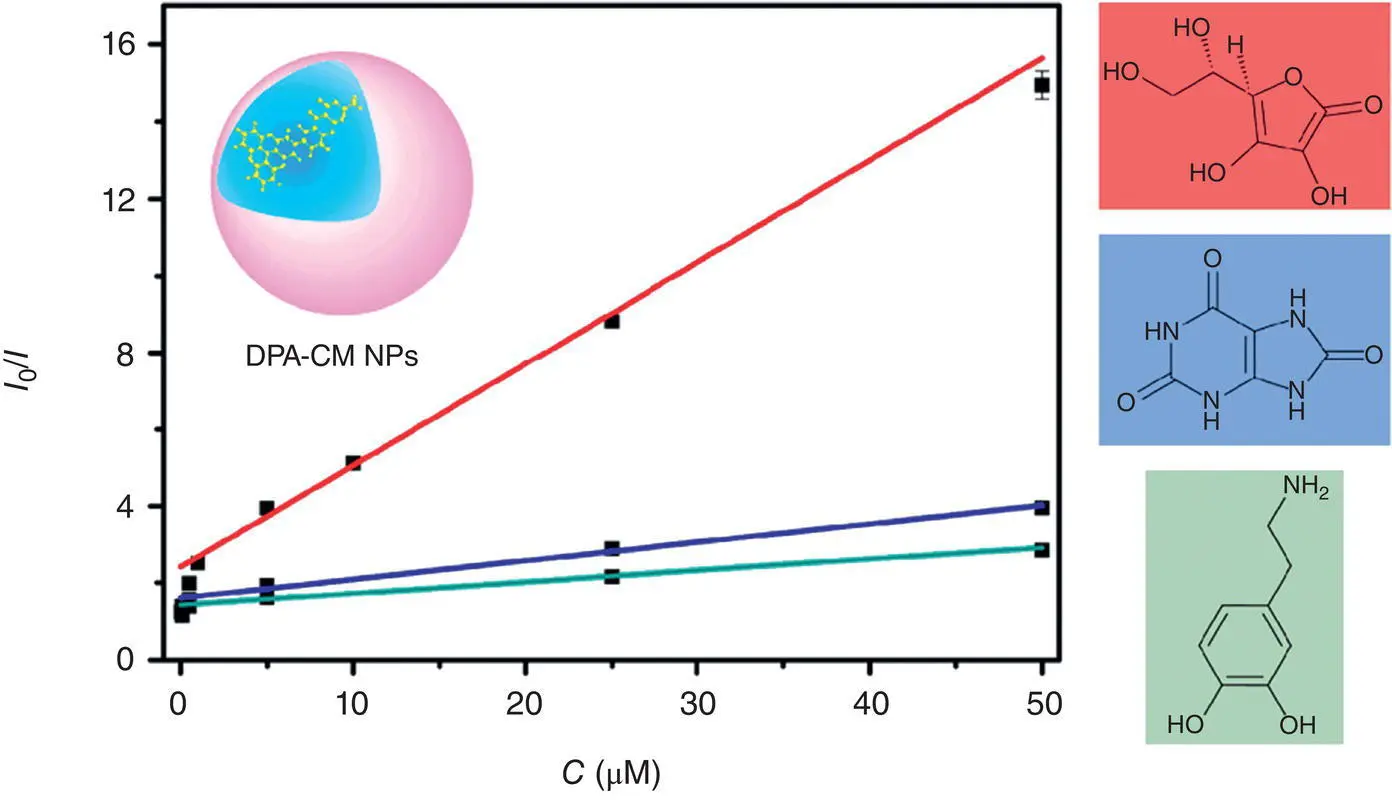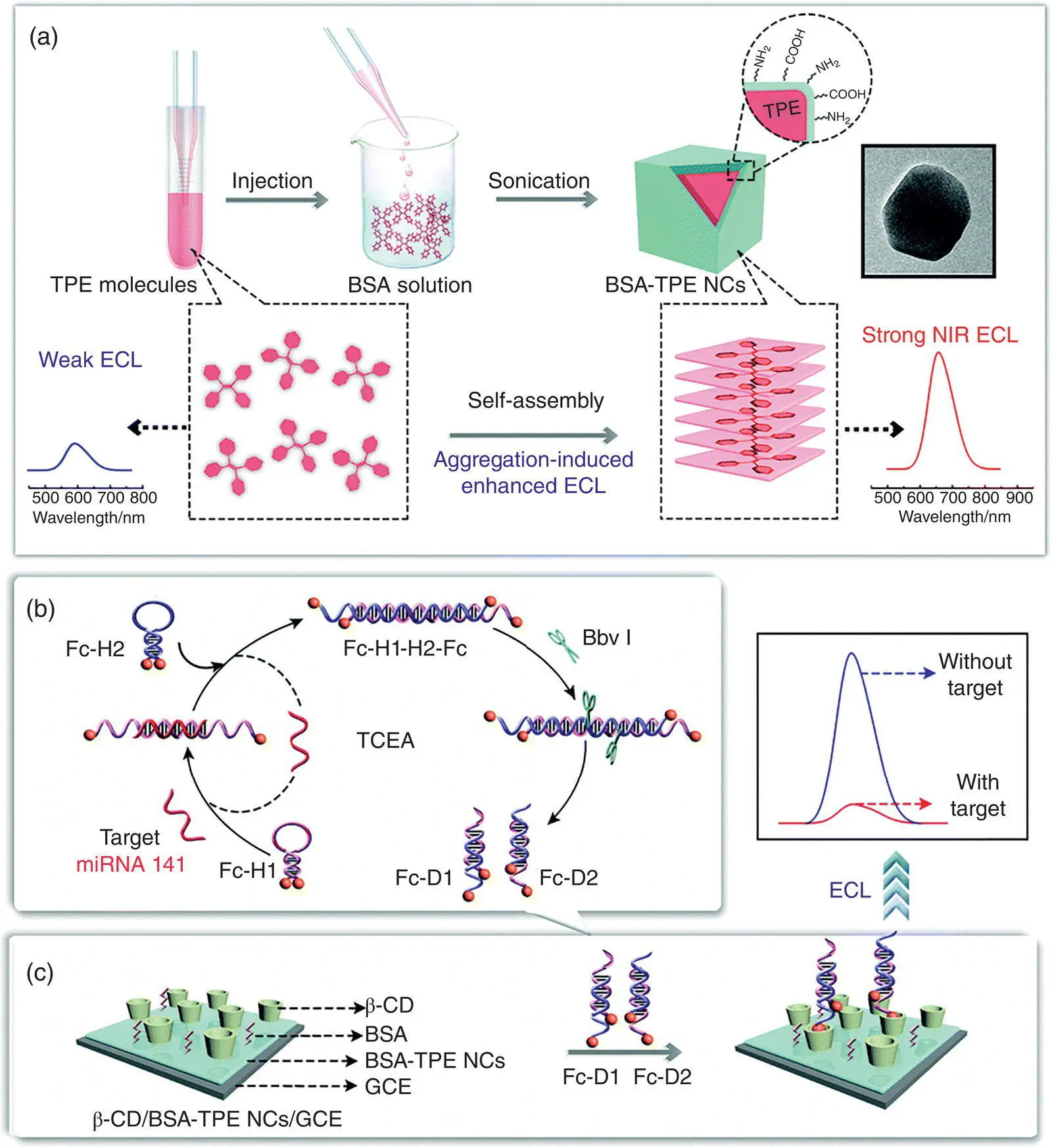Source: Readapted from Ref. [92].
Recently, a novel 2D ultrathin hybrid metal‐organic layer (MOL) was built starting from H 4ETTC (H4ETTC = 4′,4″′,4″′′,4″″′′′‐(ethene‐1,1,2,2‐tetrayl)tetrakis(([1,1′‐biphenyl]‐4‐carboxylic acid))), which is known to be an AIE‐luminophore [93]. The newly synthesized H fETTC‐MOL exhibited higher ECL intensity and efficiency than the monomers H 4ETTC, H 4ETTC aggregates, and 3D bulk H fETTC‐MOF, not only because ETTC ligands were immobilized in a rigid MOL matrix with consequent restriction of intramolecular free rotation and vibration, but also because porous ultrathin 2D MOL greatly shortened the transportation distance of ions, electrons, and coreactant TEA. The system was then used for the detection of carcinoembryonic antigen, overexpressed in most human malignancies.
4.3 Applications and Outlooks
AI‐ECL materials and techniques, various applications have become appealing, especially since they are quite efficient in aqueous solutions. Different AI‐ECL luminophores that we have described previously have shown potential bioanalyses. (AA, UA, and DA were detected by using donor–acceptor‐based coumarin organic nanoparticles (DPA‐CM NPs), considering their good AI‐ECL [81]. These important biomolecules are very important to be detected for pharmaceutical analysis, food industry, and diagnostic applications[94]. In the work of Zhang coworkers, these molecules quench the ECL emission of DPA‐CM NPs onto GC electrode in aqueous solution. In 0.1M PBS solution at pH 7.4, the quenching signal of DPA‐CM NPs for AA, UA, and DA shows linearly in the range 0.05–50 μM with detection limits of 0.04, 0.2, and 0.4 μM, respectively ( Figure 4.10).

Figure 4.10 Relationship between I 0and I of AI‐ECL of DPA‐CM NPs (inset) and concentration of AA (red trace and molecule), UA (blue trace and molecule), and DA (green trace and molecule).
Source: Readapted from Ref. [81].
Additionally, the individual quenching constant dependent on the concentration of AA, UA, and DA was calculated to be 2.6 × 10 6, 4.8 × 10 5, and 2.9 × 10 5M −1. Despite the impossibility to simultaneously detect AA, UA, and DA, their selectivity can be improved with specific recognition materials or through separation methods [47].
Quenching phenomena were studied as well for biosensing purposes by Quan’s group to detect traces of Pb 2+in aqueous solution [44]. The AI‐ECL emission could be effectively quenched by Rhodamine B (RhB) via resonance energy transfer, which led to an “on–off” emission switch. This switch was achieved by binding of the complementary DNA sequence to the aptamer of Pb 2+. When RhB interacts with preformed double‐stranded DNA on the electrode surface, the ECL signal remains in the “off” state. On the contrary, in presence of Pb 2+, the release of the aptamer forces RhB to leave the surface and be washed away, then recovering the ECL emission producing the “on” state. Another aptasensor based on AI‐ECL was fabricated by Saremi et al. by using a cyclometalated iridium(III)‐poly‐4‐vinylpyridine nanoparticles (CIPNPs) deposited on nitrogen‐doped graphene (NG) to detect Troponin I (TI), an important cardiac marker [75]. The applicability of the aptasensor was investigated in 20 random human blood samples of healthy persons and patients. The sensor was built by using SPEs on which step‐by‐step were deposited NG, aptamer‐modified gold nanoparticles, and CIPNPs. In comparison with the enzyme‐linked immunosorbent assay, the results successfully differentiate the TI level. Notably, it is the AI‐ECL material that makes it much easier to detect TI in aqueous media, giving a detection limit of 0.02 pM in relatively easy conditions.
D–A Pdots based on conjugated structures of TPE, carbazole, and dioxaborinine were synthesized to build an AI‐ECL biosensor for the detection of catechol (CA), epinephrine (EP) and DA [95]. The ECL response increased greatly by using a large amount of TPE moiety, which is a well‐known AIE‐moiety, and the aggregation in dots further enhanced the ECL emission via TPrA coreactant mechanism. These three biomolecules efficiently quench the anodic ECL emission of these Pdots. The ECL intensity showed a linear range of 10 to 500 μM and 10 to 100 μM with detection limits as 3 and 7 nM for EP and DA, respectively. Their ECL quenching mechanism can be also assigned to the energy transfer process between the oxidized product and Pdots. The specificity of the method was further confirmed by using AA and UA as interferents in the detection solution. They gave a quenching efficiency of 5.2 and 6.1%, indicating the acceptable practicability of the proposed method for DA detection in complex samples. Another fabricated “on–off” biosensor for the detection of MUC1was obtained by using TPE MCs and target‐activated bipedal DNA walker [42]. MUC1 is an overexpressed transmembrane glycoprotein in most human malignancies. The ECL signal enhanced gradually with the increase of MUC1 concentration in the range 1 fg/ml–1 ng/ml. Selectivity and sensitivity of the sensor were evaluated, resulting in a detection limit of 0.29 fg/ml, and a good selectivity by using interfering proteins which displayed low ECL signal.
MUC1 was also detected in human serum for clinical diagnosis. Standard addition method‐based recovery experiments were executed to evaluate the feasibility in whole blood samples. This application proved to be a giant leap in the use of AI‐ECL. TPE NCs were instead used to build an ECL ultrasensitive microRNA assay with a linear range from 100 aM to 1 nM and a low detection limit of 13.6 aM ( Figure 4.11) [96]. Yuan and coworkers proposed a target cycling enzymatic amplification (TCEA) to achieve efficient output of ferrocene (Fc), which is the ECL signal quencher, from target microRNA‐141 (miRNA‐141) with quadruple conversion without waste of DNA strand ( Figure 4.11b). However, the tight accumulation of biomolecules on the limited space on electrode surface could block the charge transfer and could reduce the binding event. Therefore β ‐cyclodextrin ( β ‐CD) was employed to introduce Fc into its cavity avoiding the accumulation of it. BSA‐TPE NCs, great AI‐ECL emitters, were disposed onto the electrode and their ECL properties were investigated by using TEA coreactant mechanism. β ‐CD decorated the modified electrode through the formation of amide bonds between COOH termination on the BSA‐TPE NCs and amino of the β ‐CD. TCEA was then executed to produce double‐stranded DN (dsDNA) labeled with Fc. In the absence of the target miRNA‐141, two hairpins dual‐labeled with FC (FC‐H1 and FC‐H2) kept their original state, not being recognized by β ‐CD for the big dimension and therefore not quenching the ECL signal. Instead, when miRNA‐141 is present in the system, the interaction between miRNA‐141 and Fc‐H1 allows H1 to open, to expose the complementary sequence to F2‐H2, which further catalyzes the hybridization to form dsDNA and release the target for the next cycle. In the meantime, restriction endonuclease (Bbvl) could open the dsDNA producing two kinds of dsDNA with Fc, Fc‐D1 and Fc‐D2. The latter could therefore bind with β ‐CD and finally quench the AI‐ECL emission ( Figure 4.11c).

Figure 4.11 (a) Illustration of AI‐ECL through self‐assembly; (b) schematic of the TCEA; (c) the ultrasensitive molecular recognition‐based sensing platform for miRNA‐141 detection.
Читать дальше














